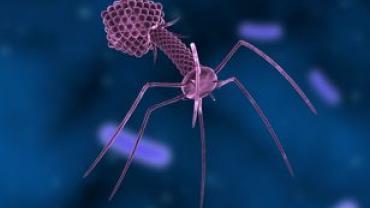
"
As antibiotic-resistant bacteria continue to be a health crisis bacteriophages (natural viruses) may be looked upon as a potential solution. Bacteriophages are the most common life form on earth and outnumber bacteria 10 to one with billions of years of experience. For every bacterium known on the planet there are legions of bacteriophages (tiny viruses that seek out bacteria and use them as a breeding ground) and destroy the bacteria in the process. They are consumed daily in virtually all fresh and non-processed foods in particular fermented foods.1 Therefore using naturally-occurring lytic bacteriophages may be the safest most green prebiotic currently available. Most people think of prebiotics as non-digestible starches that bacteria use for food not viruses that consume bacteria. According to the FDA a prebiotic is a non-digestible food ingredient that beneficially affects the host by selectively stimulating the growth and/or activity of one or a limited number of bacteria in the colon and therefore improves the health of the host. Bacteriophages are a component of the intestinal flora of healthy humans2 and have been used as human therapeutics for many years with no reports of adverse effects.3
Bacteriophages are natural enemies of bacteria so they are logical candidates for the control of foodborne bacterial pathogens. Phages ignore every cell but the strain of bacteria they have evolved to inhabit. Phages are species-specific meaning that different strains attack different bacteria. In order for bacteriophages to work the right match between phage and bacteria needs to be determined. This makes them harmless to human cells and to non-targeted bacteria which distinguishes them from broad-spectrum antibiotics which wipe out the beneficial flora in the intestinal tract along with the bacteria.
In the intestine bacteriophages readily penetrate the gastrointestinal barrier with some phages
eliciting antibody production.4 Gorski and Weber Dabrowskahave also presented evidence that some phages are helpful to humans by exerting immunosuppressive activity in the gut to control local inflammatory and autoimmune reactions.5 The bacteriophages act in concert with the immune system in immunosurveillance against bacteria and viruses. Lytic bacteriophages have been used as a prevention or treatment for many bacterial diseases for years.
How do bacteriophage work?
Bacteriophages attach themselves to specific bacteria and inject their DNA. This disrupts the bacterial genome and kills the bacteria. As a result the lysis of the bacteria cell wall releases nutrients as well as provides space for the beneficial gut bacteria.
Drawbacks of current prebiotics
Prebiotics as non-digestible starches in many cases cause gas bloating and stomach discomfort. In addition efficacy requires high doses and they typically need to be taken over a prolonged period of time. Also their activity is localized to the large intestine.
Advantages over typical prebiotics
Bacteriophages fermentation does not cause flatulence or produce discomfort. They are effective in small doses efficacious within hours and are active in the small and large intestine. Phages are common components in foods and work great with a broad spectrum of probiotics. They can be used to support overall gastrointestinal health and for both prophylactic and therapeutic applications against bacterial infections.
The growing levels of antibiotic resistance along with the departure of major pharmaceutical companies from antibiotic development really make phage therapy a wise treatment of choice for the growing number of infections. Phage therapy has an 80 to 90 percent success rate against bacteria likely to show antibiotic resistance such Escherichia coli. In contrast many antibiotics fail against evolved forms of these pathogens.
by Michael Jurgelewicz DC DACBN DCBCN